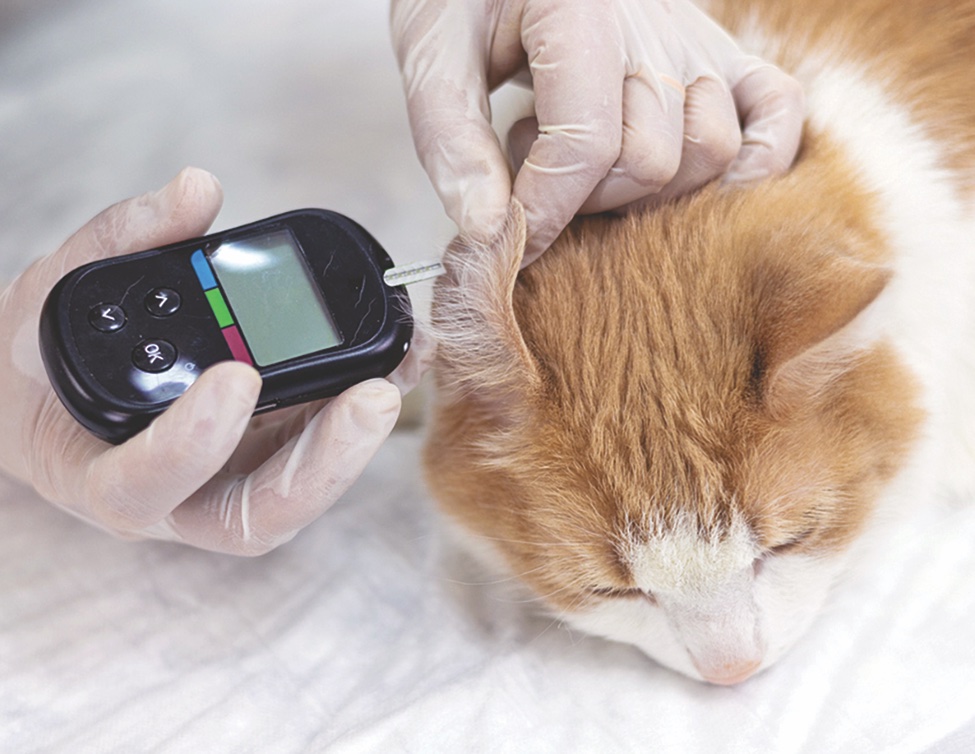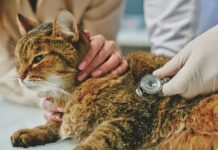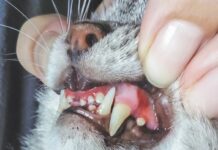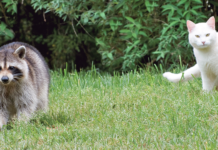The term “diabetes mellitus” roughly translates to “sweet urine” and is derived from the fact that glucose spills from the bloodstream into the urine in diabetic patients. Most cats with diabetes have a form that is similar to human type 2 diabetes. When the body is functioning properly, its cells respond to the need for fuel by putting out a call to the pancreas to produce insulin. Insulin functions like a key that opens the cells so they can take in glucose from the bloodstream and use it for energy production.
In patients with type 2 diabetes, the pancreas still produces insulin, but the body’s cells are resistant to insulin’s attempts to open them up to take in the glucose. Type 1 diabetes, in which pancreatic beta cells don’t produce sufficient insulin, is uncommon in cats.
As the cells become increasingly resistant to insulin’s message to take in the glucose, the excess glucose builds up in the blood (a state called hyperglycemia). Some of the excess glucose is excreted into the urine through the kidneys (normal urine should not contain glucose), while the rest remains in the bloodstream, where it can damage a variety of organ systems in a cat’s body.
The exact cause of diabetes is still unknown, but aging, obesity, glucocorticoid (steroid) use, and inactivity have been identified as risk factors. Burmese cats are believed to be at higher risk, along with senior cats and male cats.
Signs of Diabetes
The first signs an astute owner notices are increased thirst, urination, and appetite. If you feed meals, you may notice the increased appetite as your cat heartily wolfs down her meals and begs for more. She may also start conducting “raids,” opening cupboards and tearing open bags of all kinds of food.
The increased drinking and urination may be tricky to pick up initially if you have multiple cats. You may notice the litterbox being wetter than normal or water bowls emptying quickly, but you may need to separate cats to figure out the culprit. Another option is to put a video camera on the litterbox(es) and drinking bowls.
Weight loss caused by diabetes usually occurs gradually over time. If your previously pudgy cat is looking trimmer and you have not changed her diet or increased her activity, she might be diabetic.
The Diagnosis
Your veterinarian will examine your cat and do bloodwork and a urinalysis. On exam, your veterinarian may notice signs of peripheral neuropathy (damaged peripheral nerves), such as weakness in one or more limbs. This is often reflected in a plantigrade stance in which the hocks may touch the ground while walking or standing. Weight loss may be documented.
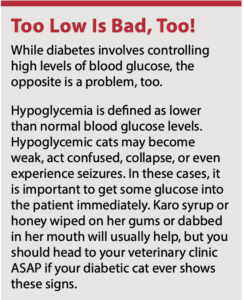
Blood glucose concentrations of 250 to 300 mg/dL (milligrams per deciliter) or higher will usually lead to glucose spillover in the urine, which will be picked up on urinalysis. Blood glucose is measured using a glucometer.
Thyroid hormone testing and tests to rule out kidney disease will usually be done, since hyperthyroidism and kidney disease can also cause increased thirst/urination and vomiting.

